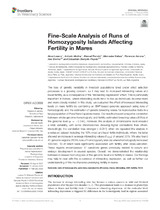Mostrar el registro sencillo del ítem
Fine-Scale Analysis of Runs of Homozygosity Islands Affecting Fertility in Mares
| dc.contributor.author | Laseca, Nora | |
| dc.contributor.author | Molina Alcalá, Antonio | |
| dc.contributor.author | Ramón, M. | |
| dc.contributor.author | Valera, M. | |
| dc.contributor.author | Azcona, Florencia | |
| dc.contributor.author | Encina, Ana | |
| dc.contributor.author | Demyda-Peyrás, S. | |
| dc.date.accessioned | 2024-02-06T22:18:47Z | |
| dc.date.available | 2024-02-06T22:18:47Z | |
| dc.date.issued | 2022 | |
| dc.identifier.uri | http://hdl.handle.net/10396/27201 | |
| dc.description.abstract | The loss of genetic variability in livestock populations bred under strict selection processes is a growing concern, as it may lead to increased inbreeding values and lower fertility, as a consequence of the “inbreeding depression” effect. This is particularly important in horses, where inbreeding levels tend to rise as individuals become more and more closely related. In this study, we evaluated the effect of increased inbreeding levels on mare fertility by combining an SNP-based genomic approach using runs of homozygosity and the estimation of genetic breeding values for reproductive traits in a large population of Pura Raza Española mares. Our results showed a negative correlation between whole-genome homozygosity and fertility estimated breeding values (EBVs) at the genome level (ρ = −0.144). However, the analysis at chromosome level revealed a wide variability, with some chromosomes showing higher correlations than others. Interestingly, the correlation was stronger (−0.241) when we repeated the analysis in a reduced dataset including the 10% most and least fertile individuals, where the latter showed an increase in average inbreeding values (FROH) of around 30%. We also found 41 genomic regions (ROHi, runs of homozygosity islands) where homozygosity increased 100-fold, 13 of which were significantly associated with fertility after cross-validation. These regions encompassed 17 candidate genes previously related to oocyte and embryo development in several species. Overall, we demonstrated the relationship between increased homozygosis at the genomic level and fertility in mares. Our findings may help to deal with the occurrence of inbreeding depression, as well as further our understanding of the mechanisms underlying fertility in mares. | es_ES |
| dc.format.mimetype | application/pdf | es_ES |
| dc.language.iso | eng | es_ES |
| dc.publisher | Frontiers | es_ES |
| dc.rights | https://creativecommons.org/licenses/by-nc-nd/4.0/ | es_ES |
| dc.source | Laseca, N., Molina, A., Ramón, M., Valera, M., Azcona, F., Encina, A., & Demyda-Peyrás, S. (2022). Fine-scale analysis of runs of homozygosity islands affecting fertility in mares. Frontiers in Veterinary Science, 9, 754028. | es_ES |
| dc.subject | Fertility | es_ES |
| dc.subject | Genomics | es_ES |
| dc.subject | Inbreeding | es_ES |
| dc.subject | Mares | es_ES |
| dc.subject | Reproductive Efficiency | es_ES |
| dc.subject | Rohi | es_ES |
| dc.subject | Runs Of Homozygosity | es_ES |
| dc.subject | Snp | es_ES |
| dc.title | Fine-Scale Analysis of Runs of Homozygosity Islands Affecting Fertility in Mares | es_ES |
| dc.type | info:eu-repo/semantics/article | es_ES |
| dc.relation.publisherversion | https://doi.org/10.3389/fvets.2022.754028 | es_ES |
| dc.relation.projectID | Gobierno de España: MINECO.AGL2017-84217-P | es_ES |
| dc.rights.accessRights | info:eu-repo/semantics/openAccess | es_ES |

